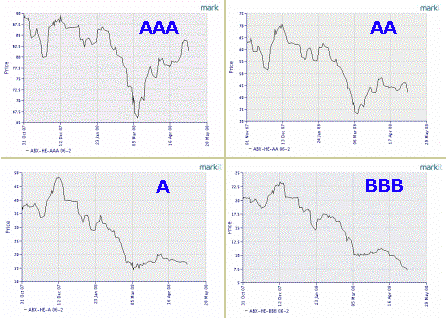 PIVOTAL EVENTS - MAY 13, 2008 PIVOTAL EVENTS - MAY 13, 2008
Signs Of The Times
Rational De-exuberance
Bob Hoye
Institutional Advisors
Posted May 14, 2008
The following is part of Pivotal
Events that was published for our subscribers May 8,
2008.
Last Year:
"After a remarkably permissive
first quarter, investors put their collective foot down in April
to slow the pace of refinancings to a near halt." -Wall
Street Journal, April 27, 2007
"Who Cares if the U.S.
Gets a Cold?" -Financial
Post, May 7, 2007
* * * * *
This Year:
"Investors are turning
to riskier investments as the turmoil that has racked stock and
bond markets now show signs of fading." -Wall Street Journal, April 28, 2008
"For the first time in
months, analysts and executives sound upbeat."
"The optimists believe
it is different this time." -International
Herald Tribune, May 2, 2008
"The worst is over."
-Warren Buffett, on Bloomberg
TV, May 3, 2008
"Stocks Rally on great
Expectations" -Wall
Street Journal, May 5, 2008
* * * * *
Stock Markets: Our main theme has been that the plunge
into January was of a character that typically ends important
bull markets. As that panic concluded our view was that the revival
in stocks, commodities, and credit spreads would run into March-April.
With this, senior stock indexes would likely retrace around 50
per cent of the loss. This has been essentially accomplished.
Although soaring crude oil
prices are stimulating the usual worries on Wall Street, we continue
with the observation that crude is another commodity that goes
up in a boom and down in the contraction. Back in October, 2002
the S&P set a low of 777 as crude plunged to 17.07, and both
started a cyclical bull market. Not all elements of a cyclical
expansion peak at the same time.
However, all cyclical expansions
end in a similar way, which was behind our conclusions beginning
last April that the good times would end with "rational
exuberance". By that we meant that spiking exuberance -
particularly in the credit markets - would mark the beginning
of the contraction.
The rational part referred
to the pattern whereby a boom runs some 12 to 16 months against
rising interest rates and an inverted yield curve. This has been
the way financial history works and as we discussed last spring,
the count had June, 2007 as the 16th month. Also emphasized was
that inversion wasn't the problem, but when the curve reverses
to steepening it shouts that the end of a great speculation is
at hand. Moreover, we noted that the senior central bank had
little, if any, influence on the curve, or spreads.
The next part of the rational
transition to a contraction is the reversal in credit spreads
from narrowing to widening and as discussed last year - May often
sees a seasonal reversal to widening, which worked out with,
so far, rather severe dislocations.
Our theme about "Rational
Exuberance" has worked out, and now it seems time for the
next phase of the big picture, which could be called "Rational
De-exuberance."
The process of ending a huge
mania begins with a critical change in the credit markets, and
the initial plunge is followed by a vigorous rebound. On this
one we have cited the example that ran until April, 1930. The
other example has been the fabulous bull market that ran until
the spring of 1937.
The latter was a five-year
bull market out of a collapse of a great mania in tech stocks,
The mania to the spring of 2000 was just such a bubble and the
bull market out of the October, 2002 washout ran for 5 years.
With so many lamentations about
soaring crude oil prices, it is going against conventional wisdom
to point out that the next phase of the contraction will involve
all asset prices going down. And declining collateral values
force a credit contraction, which disproves the arbitrary notion
that Fed injections will force prices up - the old "pushing
on a string" story.
Investors and traders should
be prepared for another slide in most prices of stocks, corporate
bonds and commodities.
Sector Comment: After reigning as the complacency
sector bank stocks took a well-deserved trashing into January
when we thought a 50% retracement rally could run out until spring.
However, as noted at the time the rebound to 98 on the BKX was
accomplished in only 10 trading days and the price-target was
met. The action since has been on one side the favourable period
likely to run into April. On the other side, there have been
reports of lending disasters, which will continue in all countries.
Our propriety Bank Trading
Guide provided another sell signal in early March and some three
weeks later the BKX set a high of 89. The original sell signal
was provided last July.
The bank index declined to
76 in mid April, when the street concluded that the worst was
over, and began to look forward to Pope Ben's scheduled blessing
of the markets on April 30. This took banks up to 88 on Friday,
which compares to the last high of 89 and the retrace at 98.
The record high was 121 in 1Q2007.
There is support at 74, but
taking that out would resume the downtrend, which seems likely.
It was not sound banking that
created the severe liquidity crisis, but a wild experiment in
financial innovation conducted by a "new" school of
wizards with no concept of risk. Such innovation has had enthusiasts
in academe, government, business, industry, all political parties
and even labour unions - not to overlook central banks.
It seems that there have been
no bankers, in the proper sense of the word, at the Bank of England
or at the Fed. These senior central banks are still in the thrall
of innovation as they believe that taking garbage securities
out of the market will kick start another credit binge. This
is not banking, but a reckless attempt at more financial engineering.
If it was in the private sector, one would say that they have
bet the ranch.
Base metal miners were also
expected to rally up to a seasonal high in March-April. The low
for the SPTMN was 598 in January, and the high has been 890 set
in mid April. The initial decline was to 790 and the test of
the high has made it to 883 on Tuesday. There is a negative divergence
as the recent highs have been against diminishing momentum and
declining accumulation. Base metals (GYX) have been showing even
worse divergences.
Credit Spreads have been expected to generally to
be benign to narrowing with the revival out of the January disaster,
and then the March trembler.
As noted last week, the lower-ranked
sub-prime bonds have been declining for a few weeks. At 11 on
April 9, the BBB has dropped to 7.32. Hey, but no need to worry
- they are stilled rated as BBB, which means investment grade.
They were priced at 100 in August, 2006.
These heading down have led
the next decline in the stock market by a number of weeks, and
the warning becomes more acute when the higher ranked ones such
as the AA roll over. That has happened this week which was accompanied
by a turn to widening in Canadian bankers acceptances, over treasury
bills.
SUB-PRIME PROBLEMS ARE RETURNING
ABX Indices - AAA,
AA, A & BBB

- Top left Chart (AAA) shows
an outstanding rally from 66 to 84. Now it is rolling over.
a
- The BBB (bottom right) led
the crises of last July, January and March.
a
- The pressure becomes acute
when the AA (top right) breaks down.
CANADIAN MONEY MARKET SPREADS
(BANKERS ACCEPTANCES VS TREASURY BILLS)

- Note the widening in the past
few days (lower panel).
a
- Note the widening going into
the July-August crisis.
a
- According to some Bay Street
strategists, Canada is immune to credit problems in the U.S.
-Bob Hoye
Institutional Advisors
email: bobhoye@institutionaladvisors.com
website: www.institutionaladvisors.com
PIVOTAL EVENTS - MAY 13, 2008
Hoye Archives
The opinions
in this report are solely those of the author. The information
herein was obtained from various sources; however we do not guarantee
its accuracy or completeness. This research report is prepared
for general circulation and is circulated for general information
only. It does not have regard to the specific investment objectives,
financial situation and the particular needs of any specific person
who may receive this report. Investors should seek financial advice
regarding the appropriateness of investing in any securities or
investment strategies discussed or recommended in this report
and should understand that statements regarding future prospects
may not be realized.
Investors should note that income from such
securities, if any, may fluctuate and that each security's price
or value may rise or fall. Accordingly, investors may receive
back less than originally invested. Past performance is not necessarily
a guide to future performance. Neither the information nor any opinion expressed constitutes
an offer to buy or sell any securities or options or futures contracts.
Foreign currency rates of exchange may adversely affect the value,
price or income of any security or related investment mentioned
in this report. In addition, investors in securities such as ADRs,
whose values are influenced by the currency of the underlying
security, effectively assume currency risk. Moreover, from time to time, members of the Institutional Advisors team may be long or short positions discussed in our publications.
321gold Ltd

|